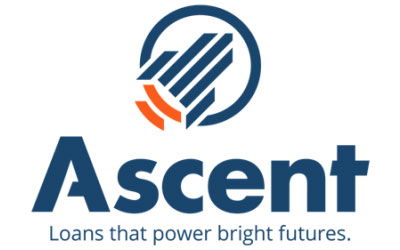Getting federal student aid is the best way to kick-start the funding of your college education. Federal student loans, grants, and work-study jobs are all excellent ways to get the money you need to pay for tuition and other college expenses.
But with costs soaring for American students across the country, federal aid often isn’t enough to cover all your needs.
That’s where private student loans come in.
8 Best Private Student Loans
If you have exhausted all your scholarship, grant, and federal loan options and still need funds, you can work with a private student lender.
Here are the best private student loan lenders of 2025 to help your search get started:
1. SoFi
SoFi doesn’t provide loans directly to students, but they do offer parent student loans. Fixed rates and variable rates both start low, and you can view current rates online.
2. Ascent
For flexible private student loan options, consider Ascent. You can get either a tuition loan that requires a cosigner or an independent loan that’s just for undergraduate or graduate students.
3. Sallie Mae
Offering a broad range of student loans, Sallie Mae can fit many needs. You can get loans for both undergraduate and graduate programs. Sallie Mae also offers parent loans if they’d rather take on the financial burden instead of the student.
4. Custom Choice
For those seeking tailored student loan options, Custom Choice is a solid contender, especially for returning students and upperclassmen. With an option to check eligibility and the rate without a hard credit pull, this lender ensures a hassle-free pre-application experience.
5. Discover
Not only does Discover offer undergraduate and graduate student loans, as well as parent loans, it also rewards students for academic achievement.
6. CommonBond
CommonBond offers student loans designed specifically for students, not their parents. You can find loans for both undergraduate and graduate programs, catering to a larger amount of private student loan borrowers.
7. Citizens Bank
Re-applying for student loans year after year can be frustrating and stressful, and you never know if you will get the funding you need.
8. College Ave
Whether you’re going to undergrad for the first time or back to grad school later in life, College Ave can help you design a student loan tailored to your situation.

When to Use a Private Student Loan
Before considering private student loans, it’s essential to explore all federal aid options.
The first step is to fill out the Free Application for Federal Student Aid (FAFSA) each year you’re in school. This application offers access to need-based financial aid, including grants, which you don’t have to repay as long as you meet eligibility requirements. Grants are an ideal source of funding because they’re essentially free money, although they typically won’t cover your total cost of attendance.
Next, look into federal student loans. While some private lenders offer competitive rates, federal loans come with additional benefits like income-driven repayment plans and potential loan forgiveness, especially for specific professions. The federal government also provides work-study programs that allow you to take on part-time jobs, often related to your field of study. Additionally, explore scholarships offered by your college, corporations, or community organizations to supplement your aid.
If you’ve exhausted all federal and scholarship options and still need funds, it may be time to consider a private student loan. While it might seem overwhelming to apply for multiple types of aid, maximizing your financial aid now can significantly ease your financial burden later on.
Pros of Private Student Loans
To help you discern whether a private student loan is the right option for you, it’s wise to get a clear picture of the pros and cons. First, let’s look at the potential upsides of a private student loan.
Higher Borrowing Limits
Private student loans usually come with higher borrowing limits when compared with federal loans. In some cases, these loans can cover the full cost of enrollment. Keep in mind that higher limits are available only to those with strong credit scores, however.
Lower Interest Rate
In the same way that borrowers with good credit can reach higher loan limits, they can also meet some low interest rates. For private loans, interest rates can potentially be much better than federal loans.
Flexible Enrollment Requirements
Another perk of private student loans concerns enrollment requirements. In the case of federal student loans, you are typically required to be enrolled for a certain portion of the year to qualify.
Private lenders, on the other hand, will offer loans to borrowers who might only take a few classes.
Fixed or Variable Rates
Private student loans more commonly offer a choice between fixed or variable interest rates. This customization can be a big benefit depending on your circumstances.
Cons of Private Student Loans
Let’s take a look at the biggest drawbacks of taking out a private loan for your education.
No Federal Protections or Benefits
One of the major downsides to private student loans is a lack of standard protections or benefits. For example, Federal student loans come with benefits such as standardized forbearance and income-weighted repayment plans.
Private lenders, however, are less likely to offer these options.
Credit-Dependent
Most federal student loans don’t check your credit to evaluate your application. For private student loans, chances are you’ll need good credit to qualify. A credit score in the mid-600s is the lower end of the credit requirement for a private student loan.
Potentially High Rates
While private loans can potentially come with lower interest rates compared to federal loans, this only applies to those with good credit. If your credit score is lower, you’ll struggle to find competitive rates with private loans.
How to Find the Best Private Student Loans
When searching for the right private student loan, consider your financial situation now and in the future. Since private loans can vary widely between lenders, careful research is key to finding the best option.
Determine Your Direct Needs
If you need a private student loan to meet your college costs, start by deciding whether the loan will be under your name or your parents’.
For direct student loans, decide if you’ll have access to a cosigner (like a parent) or if you’ll take on the burden entirely on your own. Those decisions alone can narrow down your lender.
Next, think about what your income will be like when you’re attending school. Will you have a part-time job or ample savings on hand to take care of any payments due? If not, you may need to find a lender who offers deferred payment, even if it means accruing more interest.
Gauge Your Future Needs
You may also be interested in future forbearance options. No one wants to imagine themselves as going through financial hardship once they’ve earned their degree. However, it’s a genuine possibility for anyone.
If you don’t have a strong financial safety net, you may benefit from choosing an online lender that offers repayment flexibility.
Predicting your future needs for student loan repayment is like gazing into a crystal ball, which we simply can’t do. So, the wisest way to tackle the issue is to hope for the best but prepare for the worst.
You likely don’t know what your job situation or income will be like by the time you graduate. So, try to buffer in as much flexibility as possible. Furthermore, be careful with your spending and refrain from racking up unnecessary credit card debt. Your future self will thank you!
Choosing the Best Student Loan Lender
Not all private lenders are created equally, so be sure to shop around to find the best student loans for you. The things you’ll want to compare are fees, rates, and loan terms. For example, some lenders may charge an origination fee, which can decrease the funds you get from your loan amount.
The interest rate can be either fixed or variable. If you choose a fixed interest rate, you’ll never have to worry about your payments changing if you keep on top of your payments. However, your interest (and consequently, your monthly payments) can change regularly with a variable interest rate.
The loan term determines how long you’ll repay your private student loan. A shorter term saves you in interest over time but also results in higher monthly payments. Of course, you can always refinance student loans if your financial situation is now what you expected after you graduate.
Other Eligibility Factors for Private Student Loans
Another factor to consider when researching student loan lenders is what enrollment and academic standards they require. For example, you may need to maintain a certain enrollment status, such as half-time or full-time, to be eligible. Alternatively, you may have to achieve certain academic standards to keep receiving student loans each year.
Furthermore, find out how the student lender treats repayment while you’re still in school. Deferred repayment options are sometimes available, but interest keeps accruing. That means you’ll graduate with a bigger loan balance than what you started with.
How to Apply for Private Student Loans
Applying for a private student loan is quite simple. Once you’ve narrowed down the list of banks, credit unions, and online lenders you’d like to work with, you can typically start the application process online. Expect to submit some basic personal information as well as details regarding your upcoming education costs.
You’ll most likely need the following information:
- Contact information
- Social security number
- School and program information, including your expected graduation date
- Requested loan amount and other financial aid you’ve received
- Current financial information, such as income
- Personal contacts
- Cosigner information
Applying with a Cosigner
Most undergraduate students will need to apply with a cosigner to qualify. If you have a cosigner, most lenders will ask for their contact information. Then, they will reach out to the cosigner directly to get more details from them.
Once you submit your application, the lender will review your credit history and, if applicable, your cosigner’s. You’ll then receive a decision on your application. If you’re approved, you’ll see one or more offers.
You can compare how the interest rate and payment amount change with different term and repayment options. Pick one, sign the loan agreement, and your lender will disburse the funds directly to your school.
How to Get Private Student Loans for Bad Credit
Getting a private student loan when your credit score is poor is possible. The reality is, however, you will have to choose from much higher overall loan costs.
The good news is that there are lenders out there offering student loans specifically for borrowers with bad credit. These loans are often easier to qualify for, and some don’t require a credit check at all. Lenders will review alternative lending data, including field of study, grade point average or even estimated future earnings.
Alternatives to Private Student Loans
You might be unsure whether a private student loan is the right option for you. Even if you are certain you’ll go with a private loan, either way it’s good to be aware of these alternative options.
Apply for Grants and Scholarships
Exhausting the avenues for grants and scholarships is hard work, but it could literally pay off. These types of financial aid can help make your education more affordable, and they come with the benefit of never having to be paid off.
Fill Out a FAFSA
Once you’ve sent your college application, make sure to go and complete an application for the Free Application for Federal Student Aid (FAFSA) as soon as possible. This can show you how much federal aid you may be eligible for, and includes both grants and scholarships. This is a great way to gauge your finances and help you prepare in advance if you need a private loan.
Ask About Payment Plans
Your college might offer payment plans that allow you to ease the financial burden of various costs. These plans typically cover direct educational costs, such as tuition, housing and materials. In any case, finding out about possible payment plans is essential.
Live at Home
If possible, you might want to consider living at home while you attend college. This can cut a significant portion of your costs, especially if your commute isn’t huge. Figure out an approximate cost for your commute to see whether living at home could work for you.
Get a Part-Time Job
If it’s a possibility for you, taking on a part-time job could be a huge help when it comes to affording college.
A part-time job can be a great way to help cover personal expenses or supplement a federal loan. In addition to that, your employer may even be willing to cover certain educational expenses, with benefits such as tuition assistance or paid internships.
Frequently Asked Questions
What is a private student loan?
A private student loan is a loan made by either a bank, credit union, or state-based organization. Unlike U.S. government-sponsored loans, which require the completion of a FAFSA application, these are funded exclusively by the private entity.
What is the difference between federal and private student loans?
Federal Student Loans
Federal loans are made directly by the U.S. government. Payments aren’t due until after you graduate, and interest rates are fixed. They do not require a credit check (except for PLUS loans).
During the student loan repayment period, borrowers can change their payment plan if needed. Loan forgiveness is also possible after a certain number of years has passed if the borrower works in public service.
Private Student Loans
With private student loans, the lender sets the interest rates and repayment terms, not the government. Payments are often required while the borrower is still in school, and although you can defer payments, interest often still accrues. This increases the principal balance. As for interest rates, they can either be fixed or variable.
Private loans often require a cosigner, which usually lowers the interest rate. In addition, refinancing is always possible with a private student loan, and doing so can also reduce the interest rate and the monthly payments.
How do private student loans work?
Getting a private loan doesn’t require the student to submit a FAFSA application before applying. If approved, you can use the funds for any education-related expense.
Payments begin after graduation or when enrollment drops below part-time. For most lenders, the grace period for either option is six months. After the six-month grace period has elapsed, students are expected to make payments in full.
Usually, you have the option of deferment or forbearance until you have graduated, make interest-only payments, or make full payments while you’re still enrolled. Many borrowers choose the interest-only repayment plan, so their loan principal is smaller when they graduate.
How long is a cosigner responsible for my loan?
It varies from lender to lender. Some lenders allow for cosigner release after 12 months of on-time payments, whereas others want 24 to 36 months. Some lenders also require that your gross annual income reach a minimum amount compared to your loan principal. This is not as common as the requirement for 24 months of making your payments on time.
Can I get a private student loan without a cosigner?
Most private lenders have minimum credit score requirements in the mid-600’s. So, you can apply without a cosigner if you have a strong credit score. If you’ve been in the workforce and have made payments on credit cards or car loans, you may not need a cosigner. However, students who have just graduated from high school and have zero payment history will likely need a cosigner.
How long does it take to get a student loan?
That depends on whether the loan is a certified or non-certified student loan. A certified loan first needs to be distributed to your school. It can take 1-2 weeks before you receive the remaining funds.
Non-certified loans can be obtained much faster, sometimes in as little as a few business days. However, regardless of how quickly they can process your loan, always start loan shopping as early as you can.
How much can you get in private student loans?
It depends on the student loan lender. Some larger lenders can guarantee the total cost of attendance, regardless of what it is. Smaller lenders usually have a cap, which is generally around $100,000 to $150,000. Verify with your school the total cost of attendance, and then use that number when lender shopping.
What are the typical interest rates for private student loans?
Interest rates for private student loans vary depending on the lender, your credit score, and whether you apply with a cosigner. Rates can range from as low as 4% for those with excellent credit, to over 12% for borrowers with lower credit scores.
Additionally, some lenders offer both fixed and variable interest rate options. Fixed rates remain the same throughout the loan term, while variable rates can change over time, typically based on market conditions. Be sure to compare lenders to find the best rates available for your financial situation.
Do private student loans allow deferment or forbearance?
Lenders of private student loans are less likely to allow deferment or forbearance. It isn’t impossible, but keep in mind that interest will still accrue on these loans. This is unlike federal student loans, where interest does not accrue during deferment if you have a subsidized federal direct loan.
However, there are lenders out there offering different kinds of conditional deferment. Just remember to keep a close eye on the amount of interest you’ll owe. There might also be extra fees to consider.
Can I refinance student loans?
Refinancing is similar to consolidating. To refinance, you’ll want to have a strong credit score and report. If your credit score is weak, it’s unlikely refinancing will be to your advantage.
However, if you have a good credit score, search for a lender who offers student loan refinancing. Compare private student loan rates and repayment terms to what you currently have, and make sure your remaining principal doesn’t exceed their loan limits.
When should I apply for private loans?
You should always apply as soon as possible, regardless of whether you’re working with a certified or non-certified lender. That way you don’t miss any deadlines your school has.
Sometimes approval can take only minutes, while it can take as long as a few weeks in other cases. Therefore, if you plan to apply with a cosigner, make sure you give yourself and the banks a bare minimum of at least a month. This allows them enough time to request additional paperwork they may need. It also gives you enough time to find and collect it.
Even if you don’t have a cosigner, give yourself over a month for any potential back and forth with the lender. It’s also wise to wait to see the potential financial aid results from your FAFSA application.
What are my repayment options?
Repayment options depend on the lender you choose. Overall, there are four repayment plans that most lenders tend to use:
- Deferment: With a deferment, the borrower pays nothing while they are enrolled in school. Interest still accrues, and the loan balance grows a little every day.
- Partial Interest: Some lenders offer a flat-rate monthly payment that covers part of the monthly interest. This keeps the balance growth to a minimum.
- Interest Only: The borrower pays only interest each month. This keeps the balance the same until the borrower can make full principal and interest payments.
- Principal and interest: This is a full monthly payment, which is the same payment the borrower would make after they graduate or drops below part-time enrollment.
How can I pay off my student loans faster?
There are various ways to do this.
- Make interest or principal and interest payments while you are still enrolled. This prevents your principal from growing while you are in school.
- Make an extra student loan payment whenever you can. To achieve this, always pay your minimum payment. Thereafter, try to set aside as many extra payments as you can. Many people like to make an extra payment every three months, which accounts for a total of four extra payments each year.
Before you make the extra payment, be sure to write to your lender and explain what you are doing with the extra money. If they don’t get the letter, they may just assume the money is to be put towards your next month’s payment rather than going wholly towards your principal.
- Make a large lump sum payment. Many people do this by putting their tax returns towards their student loans.
- Pay more than the minimum each month. Pay more than the minimum each month and your principal will go down more quickly. Interest accrues daily and is based on your principal. The sooner your principal goes down, the sooner you’ll start paying less in interest.
- Refinance. By refinancing, you may get a lower interest rate and better loan term.
What happens if you default on private student loans?
Defaulting on a private student loan will negatively impact your credit score, first and foremost. From there, the lender may seek repayment from your cosigner, if you have one. Then, more than likely, you’ll start receiving calls from a collection agency.
The lender may demand you repay the full amount. You could even be taken to court, have your wages garnished, or have your assets seized by the lender.
How do student loans affect your credit score?
When it comes to your credit score, a private student loan will have the same effect as any other installment loan. How you manage your debt will determine whether your student loan has a positive or negative impact on your credit score.
Since your payment history carries the most weight on your credit score, making your payments on time is key. Missed or even late payments will damage your credit score.
Keep in mind that your credit mix is also a factor in your overall credit score. A student loan could increase your credit mix and actually bring a boost to your credit score.











